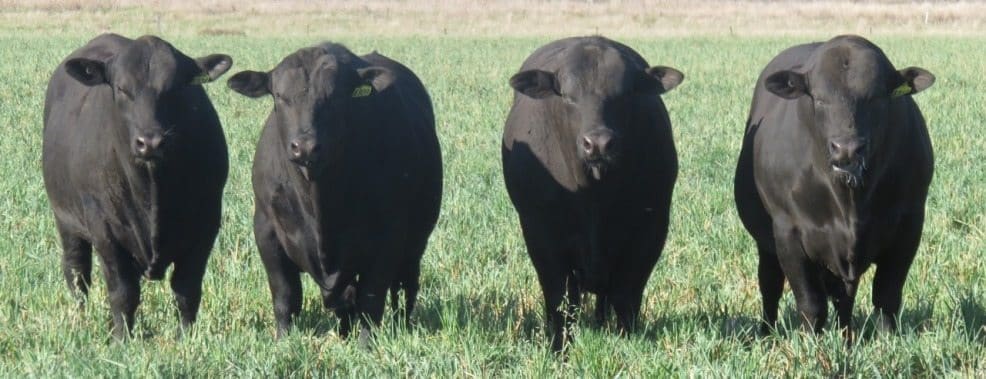
Indicus-infused Angus bulls bred in Queensland for the northern market
This week’s genetics review is the second part of our two-part series, looking at the impact that black-coated breeds are having across the beef industry. Last week’s column (click here to view) looked at the state of play in southern Australia, while this week the focus is on the north….
TAURINDICUS is not a recently discovered dinosaur species – it’s a description for a bovine carrying both Taurus and Indicus genetics.
Producers in Northern Australia (Queensland, the Northern Territory and the top half of WA) where most Taurindicus are found, are used to following moving goal posts and are adept at adapting and changing management practices to meet market and seasonal conditions.
Unreliable seasons, sometimes fractious live export markets, fertility challenges and Meat Standards Australia grading demands have prompted producers to look for solutions, and black-hided cattle have been the sanctuary for some.
Brangus have long been a major and highly-effective contributor to the black Taurindicus movement in the north, but in recent years Angus-dominant Ultrablacks have joined to market. Black Wagyu have also started to have an influence in some breeding herds.
Registered Australian Brangus contain no less than 25pc (one quarter) and no more than 75pc (three-quarters) Brahman. In contrast, American Brangus content requirements are quite different, and must be a constant blend of 37.5pc (three-eighths) Brahman and 62.5pc (five-eighths) Angus.
The Australian model allows the ‘genetic dials’ on Brangus to be set and adjusted to suit the environmental conditions, tick challenge and other constraints faced by cattlemen in in different areas.
Some enterprising northern seedstock producers have recognised the need to diversify to suit different bull clients’ requirements.
David and Prue Bondfield are best known for their high-profile industry-leading Palgrove Charolais stud, but have been breeding Angus and Brangus purebred bulls for many years on a spread of five properties in two states. Perhaps surprisingly, 250 of the 900 bulls they sold in 2016 were Ultrablacks.
Starting in 2009, Palgrove pioneered the development of the Palgrove Ultrablack. These genetics were developed to cater for clients looking for black-hided bulls delivering superior meat quality traits in progeny, while retaining a small percentage (less than 20pc, or one-fifth) of Brahman infusion for environmental adaptation.
David Bondfield describes his Ultrablacks as ‘tropical Angus’ with a sleek coat, pliable hide and a robust constitution that comes from the hint of Bos Indicus. “Meat quality of Angus in a heat tolerant package,” as he describes them.
Palgrove Ultrablacks are performance and pedigree recorded and Angus Australia’s Multi Breed Register (MBR).
Palgrove recommends using Ultrablacks as a second or third breed in a northern crossbreeding program, over Bos Indicus or British breed commercial females.
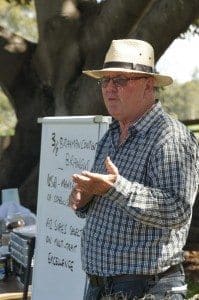
Don Nicol
Veteran industry breeding consultant and commentator Don Nicol has been involved in the development of the Ultrablack program at Nindooinbah in southern Queensland (see references below).
In addition to being involved in Australia’s beef cattle industry for decades, Mr Nicol also remains connected with the South American cattle industry, having spent six years in tropical Venezuela. He has also observed, in detail, the use of black genetics in Brazil and South America’s Bos Indicus herds.
Ten years ago in Brazil, Red Angus were favoured for crossbreeding over Brazil’s grey Nelore zebu breed, he says.
“Today, Brazil uses three million straws of Black Angus semen annually, and the Ultrablack as ideal to use across the F1 females,” he said.
Don Nicol sees a great future for the Angus-dominant Ultrablack with its Brahman-influenced slick coat for heat and tick tolerance and longer legs to cover more country for accessing feed and water.
“It’s all about getting the maximum amount of Angus (meat quality) genetics into a herd using bulls that can survive and operate cost effectively”
“There is some research in Brazil that suggests black coats are better at repelling ultra violet rays, while in Australia it is accepted that black coated cattle handle the hotter conditions by resting in shade in the hot parts of the day and grazing in cooler periods,” he said.
“It’s all about getting the maximum amount of Angus (meat quality) genetics into a herd using bulls that can survive and operate cost effectively,” he said.
One of the first in Australia to identify the need to produce high Angus content tropicalised cattle was Nindooinbah at Beaudesert in south-east Queensland. While it also produces Brangus and Angus cattle in some volume, Nindooinbah is best-known for its Ultrablack breeding program. Beef Central wrote about the Nindooinbah program in detail in this earlier article.
Manager Nick Cameron said the operation commenced in 2009 with the purchase of 650 performance-recorded registered Lawson Angus cows. These were joined to performance recorded American Brangus bulls (3/8 Brahman and 5/8 Angus) resulting in an animal containing 3/16 (18.75pc) Brahman and 13/16 (81.25pc) Angus.
This combination has too much Angus content to be defined as a Brangus animal.
Nindooinbah records an extensive range of traits including weights at birth, 200, 400 and 600 days, scans at 400 days, hair and temperament scores and structure. This has helped identify the superior genetics, and these were multiplied through one of Australia’s largest artificial breeding programs, both ET and AI.
Initially, data was collated and analysed through Angus Australia’s Multi Breed Register. Today, with its own database of over 10,000 cattle, Nindooinbah has developed its own genetic discovery performance recording program.
Mr Cameron has evidence to suggest that the high Angus content Ultrablacks perform very close, if not equal to pure Angus for carcase and meat quality.
“The Ultrablacks have the Angus fertility and fat cover but the Brahman infusion makes them slick coated, better foragers in the harsher environments and introduces heat resistance. The Angus influence cleans up the sheaths and lessens the humps and ears and all our Ultrablacks are polls,” he said.
Fertility is also a major plus for the Ultrablack cattle. At the Georgina-Hughes Pastoral’s Lake Nash on the Northern Territory side of the NT/Queensland border near Mt Isa, 15-month-old Nindooinbah Ultrablack bulls along with black Wagyu bulls do the job in a herd of 13,000 purebred Wagyu females, 20,000 composites and 15,000 Ultrablacks.
Lake Nash is just one property in the Hughes/Georgina pastoral empire which covers 2.7 million hectares in Queensland and the NT, mainly stocked with black cattle – either Wagyu cross or Ultrablacks.
Horses for courses
Burenda Angus and Brangus based at Dalby on Queensland’s Darling Downs have been selling Brahman-influenced Angus bulls for the last 10 years.
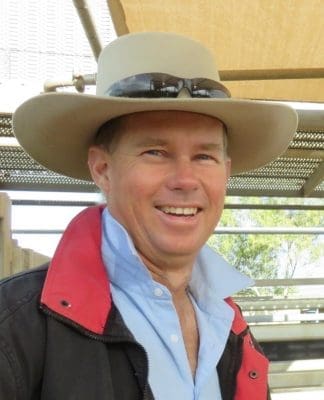
Jono Schmidt
“We never marketed them as an ‘Ultrablack type’ bull, but chose to call them Burenda Blacks, as they don’t quite fit into the Ultrablack mould of say, Palgrove or Nindooinhah,” said manager Jono Schmidt.
While Palgrove and Nindooinbah’s Ultrablack models carry around 82pc Angus and 18pc Brahman content, the Burenda Black sale bulls and females can carry a range of Angus content from 60pc to 85pc.
“I haven’t stabilised our composite at any particular Angus percentage. When we sell at Clermont (on Queensland’s Central Highlands), we like to offer a spread of Burenda Black bulls with varying contents, to give buyers in different geographic locations some options to suit their country.
“In saying that, the biggest proportion of the bulls are around 75-80pc Angus content. And it is these bulls which buyers look for, as they are after herd improvement traits that 100pc Angus bulls sometimes cannot deliver on,” he said.
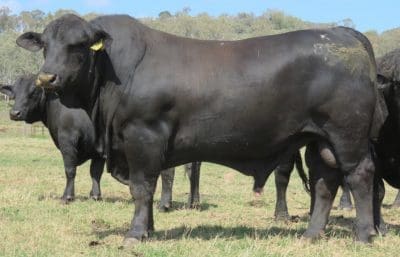
Example of a Burenda Black bull from the most recent sale catalogue
“Angus bulls have a lot to offer commercial Bos Indicus herds in western and northern Queensland with improvements in fertility, docility, growth and carcase qualities. We would all like to buy 100pc Angus bulls, but the realities of this become obvious when we assess our sires in the more challenging northern environments.
“Angus bulls can fall short in these areas, mostly due to the impact of excessive tropical heat, poor buffalo fly and tick resistance, poorer quality forage availability and greater distances to water/feed,” Mr Schmidt said.
“Hence we generally see a reduction in overall performance and life expectancy of these bulls.”
In the most recent sale offering, the Burenda Blacks averaged 122sq cm for EMA and 5.6pc for IMF, with three three bulls carrying an IMF% above 7.0. The Angus averaged 123sq cm for EMA and 6.5pc IMF.
Circle 8 does the full circle
Last week’s column on coat colour in southern Australia produced several responses from readers, including an interesting anecdote from Jeremy Cooper, principal of the Circle 8 Stud near Marulan, NSW.
Mr Cooper in 1996 studied at Michigan State University under an Angus Australia youth scholarship. There he was mentored by beef industry guru Professor Harlan Ritchie, now deceased.
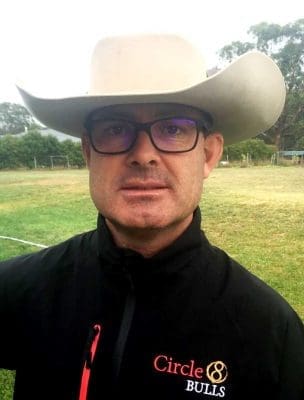
Jeremy Cooper
Jeremy was fascinated by the American Simmental’s efforts to claw back market share from Angus by developing solid-coloured black and red Simmentals and moderating extremes in the breed.
On return to Australia he continued to breed his Circle 8 Angus (and still does), but in 2004 took the plunge and imported Black Simmental embryos from the US with figures based on the US grainfeeding system. It soon became evident that more Angus content was needed, so he moved to SimAngus crosses.
One major lotfeeder had a ‘negative attitude’ towards the Simmental content in the cattle and despite spending $385,000 in advertising and selling 650 bulls, “the mathematics did not add up,” according to Jeremy.
“They were excellent cattle, but it was all too hard (given the market resistance), so I sold the SimAngus herd,” he said.
After the Black Simmental/SimAngus episode, he kept on with his Black Angus, but his attention was soon drawn to another black-coated breed, Wagyu.
“The Wagyu X Angus is the ultimate eating experience and discerning consumers world-wide are demanding this high quality product,” he said.
So in 2014 he started to research the Wagyu breed and in 2015 purchased his first Wagyu. His on-going Angus experience meant he understood the importance of performance recording, and has selected the Wagyu genetics accordingly. As a result, he is producing calves in the top 1pc of Wagyu’s Fulblood Terminal Index. Some of these elite embryos have been listed for the Elite Wagyu Sale being held on May 3.
The first Circle 8 Wagyu were born in August last year, from male sexed semen. These bulls will be available and ready for work at 15 months of age in November this year.
